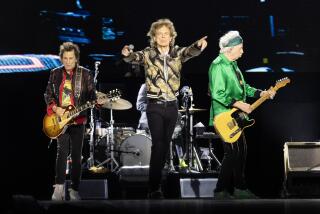Cleveland Rocks After Museum Brings It Fame : Rock and Roll Hall of Fame is boon for the city, but some wonder if it will last.
- Share via
CLEVELAND — In the fall of 1995, some of the biggest names in rock gathered in this working-class city to mark the grand opening of the Rock and Roll Hall of Fame and Museum on the shores of Lake Erie.
Bruce Springsteen, Bob Dylan, Chuck Berry and other stars capped a weeklong celebration with a seven-hour concert in front of more than 80,000 people at the old Cleveland Municipal Stadium.
It was a triumphant moment for the civic leadership in Cleveland and for their music-industry partners from the New York-based Rock and Roll Hall of Fame Foundation. The city had battled for nearly a decade to win the right to build the hall of fame, then spent nearly $100 million in public and private money to make it a reality.
The hall of fame’s celebrated induction dinners continue to be held in New York, where tonight Billy Joel, Paul McCartney, Curtis Mayfield, Bruce Springsteen, the Staple Singers, the late Del Shannon and the late Dusty Springfield will be inducted in the artist category, introduced by an equally glittering array of pop stars including Ray Charles, Bono, Neil Young and Lauryn Hill.
But the museum itself remains here, the centerpiece of the city’s renaissance--a powerful economic engine that pumps an estimated $40 million a year into the local economy. It has also become a thriving cultural institution with an ambitious, engaging annual schedule of exhibitions and programs.
The museum has mounted several special exhibitions over the past three years, including a comprehensive examination of rock’s 1960s psychedelic era that was mounted in 1997. A new, high-tech hall of fame chamber, with a big-screen video presentation, opened last year. A major exhibition marking the 20th anniversary of rap opens in September. Educational programming has also become a key ingredient in the rock hall’s success, including the American Music Masters Series, an annual tribute to an American musical pioneer whose work has had a dramatic influence on rock ‘n’ roll and popular culture.
“I’m very proud of what we’ve accomplished,” says James Henke, vice president of the museum’s curatorial division. “And we are still a very new institution. We are still trying to figure out what it means to be a rock museum. There are no blueprints because there is no other museum like it in the world.”
Not everyone in Cleveland is so sure the rock hall can maintain its success over the long haul. Much of the concern stems from repeated upheavals in the museum’s administration. Henke and Robert Santelli, the museum’s vice president of education and programming, have been there from the beginning, but Terry Stewart is the museum’s fifth chief administrator since 1995.
The high turnover has raised serious questions in Cleveland about the rock hall’s long-term stability. It has also highlighted long-standing tensions between the Cleveland and New York factions on the museum’s board of directors.
Three of Stewart’s predecessors--Dennis Barrie, William N. Hulett and David T. Abbott--resigned amid reports of conflicts with New York board members, particularly Rolling Stone magazine editor and publisher Jann S. Wenner, who has frequently taken an active role in the day-to-day operation of the museum.
Wenner declined to be interviewed for this story. But Stewart says he made it clear to both the New York and Cleveland contingents that he would not take the rock hall job unless they gave him the necessary authority to run the institution.
“I don’t think it was that big an issue,” he says. “I just made it clear that if we were going to succeed at this, there couldn’t be daily interference from individual board members. You just can’t exist in that kind of environment. Nobody seemed to have a problem with that, including Jann. I think a lot of the difficulty in the past stemmed from some organizational problems here.”
Declines in the museum’s attendance have also raised concerns in some quarters in Cleveland. The museum attracted 872,000 visitors in 1996, its first full calendar year of operation. That number dropped to 615,000 in 1997 and officials are projecting attendance of 528,000 for 1999.
“In my heart of hearts, I think this place should do between 600,000 and a million customers a year,” says Stewart, who took over the top job at the museum after a long stint as a top executive of the Marvel Entertainment Group, the comic book giant.
A dropoff in attendance was anticipated as the novelty of the museum wore off. Even at 500,000 visitors, the rock hall draws more paying customers than comparable museum attractions such as the Baseball Hall of Fame, Pro Football Hall of Fame and Country Music Hall of Fame.
Stewart says the museum was “slightly profitable” in 1998 and will be “substantially more so” in 1999. The challenge, he says, is to come up with a plan to boost attendance while increasing revenues generated from non-box office sources such as merchandising, licensing and corporate sponsorships. Stewart says the museum must also get more aggressive in raising money from outside sources to help offset operating expenses and the cost of mounting new exhibits--not just corporate sponsors, but also music-loving benefactors who might want to leave a legacy to the museum.
“Attendance really isn’t the most important issue,” he says. “It’s more critical that we restructure our development program to go after those corporate donors, individual donors and foundation grants. If we succeed at doing that, we won’t have to worry about relying on operations to sustain the museum. Money from attendance and merchandising will sustain us, but they won’t get us where we want to go.”
More to Read
The biggest entertainment stories
Get our big stories about Hollywood, film, television, music, arts, culture and more right in your inbox as soon as they publish.
You may occasionally receive promotional content from the Los Angeles Times.










